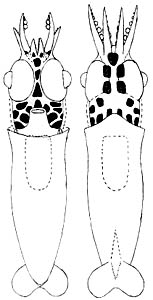Neoteuthidae
Michael Vecchione and Richard E. Young- Alluroteuthis Odhner, 1923
- Neoteuthis Naef, 1921
- Nototeuthis Nesis & Nikitina, 1986
- Narrowteuthis Young and Vecchione, 2005
Introduction
The Neoteuthidae contains weakly muscled species of small to moderate size (up to 27 cm). They are distinctive in having peculiar fins in which free posterior fin lobes are present and anterior lobes are absent. In addition, the fins attach laterally on the mantle muscle. The tentacular club is unusual in having the manus divided into two distinct regions: a proximal-manus carrying numerous small suckers in irregular series and a distal-manus mostly carring four regular series (may be slightly more suckers in initial portion) of larger suckers. The appearance of the club is similar to that of some species of brachioteuthids. Little is known about the biology of this group.
Diagnosis
An oegopsid ...
- with more than 10 irregular series of suckers on proximal manus of tentacular club.
- with anterior attachments of fins to the sides of the mantle rather than on gladius.
- with free posterior lobes on fins.
Characteristics
- Arms
- Arms with biserial suckers.
- Buccal connectives attach to the dorsal margins of arms IV.
- Tentacles
- Suckers mostly in four series over distal manus and dactylus. (The number of series may be slightly more at the interface between the proximal and distal manus and, in NewGenus, somewhat less on the distal portion of the dactylus.) Proximal manus with more than 10 irregular series.
- Club locking apparatus extends, at least, along the length of the proximal manus.
 image info
image info
 image info
image infoFigure. Top - Oral views of tentacular clubs of Neoteuthis thielei, 83 mm ML, off California. drawing from Young, 1978. Bottom - Alluroteuthis antarctica, Antarctic waters. Drawing from Roper, et al., 1969.
- Funnel
- Funnel with straight locking-apparatus.
- Fins
- Anterior fin lobes absent; posterior fin lobes free.
- Fins mostly attach to dorsolateral sides of mantle.
 image info
image infoFigure. Left - Dorsal view of mantle of Neoteuthis sp., 83 mm ML, off California (from Young, 1972). Right - Ventral view of mantle of Alluroteuthis antarctica (from Roper et al., 1969).
- Photophores
- Photophores absent.
- Skin
- Outer surfaces of arms, head and mantle with thick white tissue (presumably silver in life) in most genera.
Comments
The genera are compared in the following table:| Genus | Club length | Proximal-manus length relative to remaining distal club length | tentacle locking apparatus | Manal sucker laterally compressed | Two greatly enlarged suckers on distal manus | Arm sucker dentition | Fin length |
|---|---|---|---|---|---|---|---|
| Alluroteuthis | 33% ML | <1/3 X | Manus, stalk | No | No | Single large tooth | 35-40% ML |
| Neoteuthis | 60% ML | 4.8 X | Manus | No | No | Truncated teeth | 70% ML |
| Nototeuthis | 37% ML | 3/4 X | Manus, stalk | No | Yes | Truncated teeth | 60% ML |
| Narrowteuthis | 20% ML | 1.1 X | Manus, stalk | Yes | No | Smooth | 35% ML |
Nomenclature
A list of all nominal genera and species in the Neoteuthidae can be found here. The list includes the current status and type species of all genera, and the current status, type repository and type locality of all species and all pertinent references.
Life History
The paralarva of any Neoteuthis species has not been positively identified. However, a paralarva off Hawaii was tentatively identified to this genus by a process of elimination rather than the more reliable process of following a size series to identifiable juveniles. One of the keys to identification is the position of the digestive gland in an anterior postion adjacent to the cephalic cartilage. This feature is usually characteristic of families with buccal connectives that attach to the dorsal borders of arms IV.
Figure. Ventral and dorsal views of a paralarva tentatively identified as Neoteuthis sp., 5.9 mm ML, Hawaiian waters
References
Nesis, K. N. and I. V. Nikitina. 1986. New genus and species of squid of the family Neoteuthidae (Cephalopoda: Oegopsida) from the south-eastern part of the Pacific Ocean. Zool. Zhurnal, Mos. 65: 290-294.
Roper, C. F. E., R. E. Young and G. L. Voss (1969). An illustrated key to the families of the order Teuthoidea. Smiths. contr. zool., 13:1-32.
Young, R. E. 1972. The systematics and areal distribution of pelagic cephalopods from the seas off Southern California. Smithson. Contr. Zool., 97: 1-159.
Title Illustrations
| Scientific Name | Neoteuthis |
|---|---|
| Location | Bahamas |
| Comments | collected by submersible |
| Life Cycle Stage | juvenile |
| Copyright | © 1996 Ron Gilmer |
| Scientific Name | Neoteuthis thielei |
|---|---|
| Location | off California, USA |
| Reference | Young, R. E. 1972. The systematics and areal distribution of pelagic cephalopods from the seas off Southern California. Smithson. Contr. Zool., 97: 1-159. |
| View | dorsal |
| Size | 83 mm ML |
| Copyright | © Richard E. Young |
About This Page
National Marine Fisheries Service
Systematics Laboratory
National Museum of Natural History
Washington, D. C. 20560
USA
Richard E. Young
Dept of Oceanography
University of Hawaii
Honolulu, Hawaii 96822
USA
Page copyright © 2003 and Richard E. Young
Citing this page:
Vecchione, Michael and Young, Richard E. 2003. Neoteuthidae . Version 01 January 2003 (under construction). http://tolweb.org/Neoteuthidae/19417/2003.01.01 in The Tree of Life Web Project, http://tolweb.org/









